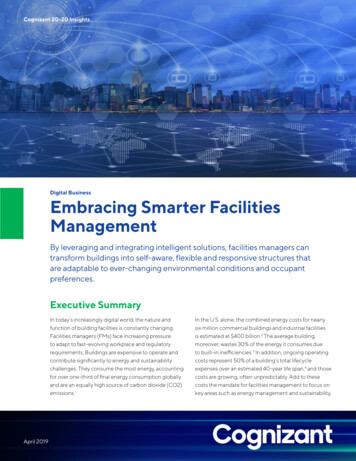
Transcription
Cognizant 20-20 InsightsDigital BusinessEmbracing Smarter FacilitiesManagementBy leveraging and integrating intelligent solutions, facilities managers cantransform buildings into self-aware, flexible and responsive structures thatare adaptable to ever-changing environmental conditions and occupantpreferences.Executive SummaryIn today’s increasingly digital world, the nature andfunction of building facilities is constantly changing.Facilities managers (FMs) face increasing pressureto adapt to fast-evolving workplace and regulatoryrequirements. Buildings are expensive to operate andcontribute significantly to energy and sustainabilitychallenges. They consume the most energy, accountingfor over one-third of final energy consumption globallyand are an equally high source of carbon dioxide (CO2)emissions.1April 2019In the U.S. alone, the combined energy costs for nearlysix million commercial buildings and industrial facilitiesis estimated at 400 billion.2 The average building,moreover, wastes 30% of the energy it consumes dueto built-in inefficiencies.3 In addition, ongoing operatingcosts represent 50% of a building’s total lifecycleexpenses over an estimated 40-year life span,4 and thosecosts are growing, often unpredictably. Add to thesecosts the mandate for facilities management to focus onkey areas such as energy management and sustainability,
Cognizant 20-20 Insightsand a challenging business management pictureemerges.While a variety of building automation andmanagement systems have been deployedover the last few years, most FMs do not takeadvantage of them. According to the AmericanCouncil for an Energy-Efficient Economy(ACEEE), the deployment of intelligent efficiencyin buildings is prevented by significant challengessuch as replacement cycles, learning to processexponentially larger volumes of data, lack ofconsistency in data communication betweenplatforms and misinterpretation.5 FMs lack truevisibility into the operations of their buildingportfolio. Managing multiple disparate systems withlimited or no interoperability requires more manualintervention than should be needed in today’sdigital era, and demands reactive maintenanceefforts that can and should be avoided at all costs.Meanwhile, accelerating technology cycles areunearthing capabilities to build smarter and moreresponsive buildings that are increasingly selfaware and in-tune with the needs of its occupants.2/Digital transformation and the Internet of Things(IoT) are delivering unprecedented opportunitiesfor facilities management to optimize operatingconditions by providing deeper insights andbetter services. By leveraging these intelligentsolutions and integrating them with both buildingand enterprise systems across globally distributedportfolios of buildings, FMs can help organizationsachieve ever-increasing levels of operationalefficiency, cost savings, occupant comfort andproductivity. They also enable facilities to meetenvironmental responsibilities such as GreenCompliance, Waste Reduction and Zero NetEnergy (ZNE) readiness.This white paper illuminates the manifoldchallenges FMs face and highlights how ourintelligent platform can enable organizations tooperate smarter facilities. It also offers insightsand recommendations for organizations tocreate facilities of the future — buildings that areflexible, responsive and adaptable to changingenvironmental conditions and occupantpreferences.Embracing Smarter Facilities Management
Cognizant 20-20 InsightsOpportunities abound for smarter facilitiesmanagementThe future holds exciting opportunities for FMs as aresult of new technologies and the push by sociallyresponsible executives for sustainability. Thesebusiness leaders see the deployment of buildingsolutions as a way to enable smarter facilitiesmanagement services that can transform safety,comfort and efficiency for their people and relatedorganizational assets. According to ContinentalAutomated Buildings Association (CABA), facilitieswith fully interoperable systems tend to performbetter, have lower maintenance costs and have asmaller environmental imprint.4 They also help meetenvironmental responsibilities such as lower energyconsumption, reduced carbon footprint and evenZero Energy readiness.Organizations that pursue these initiatives viasmart facilities management will find tremendousopportunities for innovation and productivityacross all categories of buildings. This is alreadyplaying out in a variety of ways: Residential buildings: The convenience of thedigital smart home is being enhanced every daythrough developments in sensing, control andautomation. Technologies from voice assistantsto wearables can be used to factor in proximityas well as personal preferences, and to automatesettings for lights, temperature and variousother home appliances. Wearables can tap intoa person’s body temperature and automaticallyadjust thermostats in rooms throughout thehouse to settings configured by the user.On the energy front, the U.S. Department ofEnergy is promoting the adoption of energyefficient technologies and methods in newhomes through the Zero Energy Ready HomePrograms. The Building Technologies Office(BTO) strives to reduce by 2025 the energy usedfor space conditioning and water heating insingle-family homes by 40% from 2010 levels.6 Commercial buildings: Offices are well ontheir way to defining new ways of working.A facility is no longer just about providinga place to work; it is more about offering anexperience that attracts and retains a talentedworkforce. “Hot desking” — a concept whereworkspaces are assigned to employees basedon schedule: sitting desks, standing desks, workbooths, meeting rooms, etc. — encouragesnew relationships, chance interactions and theefficient use of space. Desks are only used whenrequired, which allows employees to break awayfrom fixed locations. Mobile apps can registeremployee preferences for light and temperature,suggest desks, tweak the environmentautomatically, help find parking spaces or othercolleagues, and report issues to the facility teamin real time.A facility is no longer just about providing a place to work;it is more about offering an experience that attracts and retains atalented workforce.3/Embracing Smarter Facilities Management
Cognizant 20-20 InsightsQuick TakeEnergy Schedule AutomationWe developed a schedule automation module as part of the 1Facility solution at thepremises of a leading U.S. department store chain. This module automatically managesenergy schedule variance requests from store managers for their HVAC and lightingsystems across 2,000 stores.The solution involved integration with multiple controllers — proprietary, legacy and variousthird-party, multi-generation — to monitor and validate input against business rules andinitiate action for respective stores. It also can notify and react to approvals, and track andreport change requests from managers. In addition, the solution utilizes availability of datato derive insights on seasonal requests, geography-based patterns, and other types ofcorrelation and analytics.The solution enabled a single point of control and automated coordination between thevarious lighting and HVAC systems across multiple locations. Store managers were able toeasily operate services for extended hours and also derive optimal energy use.Many offices are pushing the boundaries forenergy savings and green compliance. Forexample, The Edge, a commercial office buildingin Amsterdam, uses 70% less electricity thancomparable commercial office buildings.7 Whenthere are no occupants, there is next-to-zeroenergy use. Airports: In the next 20 years, passenger trafficis set to double, reaching 7.2 billion; additionally,there will be 30% more freighters flying.8Airports need to be able to meet passengerexpectations, reduce processing time on theground and provide greater predictability. Fromoptimal coordination of ground services topredictive modeling of airport operations andaircraft turnaround, airports can explore variedopportunities for efficiencies.4/FMs must plan for heightened passengerexperience at every terminal with reduced waittime and service queues. Real-time tracking ofluggage with smartphone apps that identify theprecise location of passenger bags is a neartime feature. Soon passengers will be able tochoose when and where to pick-up or drop-offbags. Intelligent solutions can help airportsand similar public centers enable businessesto target customers with messages based ontheir proximity. Video analytics can managequeue congestion and washrooms can beserviced based on real-time usage. Passengersknowing where they need to be and when, withsmartphones issuing reminders, will free themup to make better use of their time, leading to abetter airport experience.Embracing Smarter Facilities Management
Cognizant 20-20 InsightsDigital transformation enables smarter facilitiesDigital, in the form of IoT, AI and mobile, isfundamentally changing how the building, itsoccupants and operators work. From wearablesto conversational assistants, and from augmentedreality to artificial intelligence, new developmentsare emerging daily to help FMs more effectively andefficiently manage their responsibilities, providepersonalized services and enhance occupantcomfort. The Wynn hotel chain recently announcedthat by the end of 2017, every room in its Las Vegashotel will be equipped with an Amazon Echo — a“digital butler” that assists guests with openingcurtains, setting room temperatures, turning on theTV and ordering room services.9 Internet of Things: Sensor technology hasenabled the systematic capture and harnessingof data to provide visibility into buildingportfolio operations like never before. It is nowpossible to measure, monitor, and managethe condition of practically everything in theenvironment in near-real time. Buildings cannow record enormous amounts of data acrossan increasingly diverse array of functions. Datacollection, storage and analysis have becomecritical features of building systems, and thosefacilities which can best analyze their data willgain competitive advantages.FMs can make use of various intelligent buildingsystems to solve a multitude of challenges inoperations and maintenance. Data collectedfrom lighting, occupancy sensors, security,HVAC, electrical plug loads and utility meters,to name a few sources, can provide valuableusage patterns to inform and drive continuousimprovements. Insights can help reducegreenhouse gas emissions and conserveelectricity by operating systems on demand.Buildings can utilize video and image analyticsto improve tenant safety and security, analyzepatterns in human movement and correlate withdata from occupancy sensors to improve spaceutilization. Digital twins: Powered by thousands of IoTenabled sensors monitoring around the clock, itis now possible to build a digital representationof every asset in the building — from HVACs toelevators. This dynamic digital model will overtime become a virtual twin. These digital twinsharness data from sensors that are monitoringthe performance of assets in the real world. Thenthey apply algorithms that offer continuousinsight and support reasonable futureprojections, based on how the digital twin’sdynamic model responds to the data from itsphysical twin’s sensors. By implementing a digitaltwin — comprising data sensors and monitors,a digital brain and a communications protocol— the service team will know not only when toinspect or service a machine, but what parts tohave on hand when doing so and how long themachine will be out of service. Artificial intelligence: The AI that now drivescars can also operate our buildings, perhapseven better than we can. Google revealed in2016 that by using AI the company was ableto reduce its data center cooling bills by 40%,Data collection, storage and analysis have become critical featuresof building systems, and those facilities which can best analyze theirdata will gain competitive advantages.5/Embracing Smarter Facilities Management
Cognizant 20-20 InsightsBy implementing a digital twin — comprising data sensors and monitors, adigital brain and a communications protocol — the service team will knownot only when to inspect or service a machine, but what parts to have onhand when doing so and how long the machine will be out of service.which clearly is a huge improvement in anylarge-scale energy-consuming environment.10Machine learning is capable of stretching theboundaries of building systems to learn andimprove. Myriad sensors, coupled with theenormous data surrounding every aspect of thebuilding’s operations, provide the necessaryimpetus to drive performance. We expect thatAI solutions will leverage the IoT infrastructureto unlock value for businesses. Imagine in thenear future, those voice assistants powered byAI at the Wynn resort, learning the habits andpreferences of guests to anticipate servicerequests. Mobile: Smartphones are the passport tofacilities. The ubiquity of mobile devices hassparked the demand for creating the nextgeneration of cloud-based applications or appsthat are intuitive and easy to run — anywhere, anytime. The rise of mobile technology (devices andapps) offers FMs flexibility and control of dailyoperations, better reporting and huge potentialto improve service levels. They can easilymanage assets, collaborate with co-workers orcustomers, and manage workforce allocation.Field service technicians can use augmentedreality and remote assistance to consult live onsite, seek expert advice on the job to secure afirst-time fix, improve the work process flow andreduce costs.Implementing intelligent building solutionsToday’s global organizations need to effectivelymanage multiple facilities distributed across variouslocations and also support ever more mobile andflexible workforces in those settings. Most modernworkplaces are powered by a multitude of buildingsystems and applications. Managing these systemsto ensure operational efficiency while retaining aseamless occupant experience is a priority for thevarious workplace maintenance stakeholders.However, several processes and technologicalchallenges in the facility management space6/prevent them from leveraging the wealth ofinformation available for achieving these ends (seeFigure 1, next page): Management of disparate building systems. Absence of comprehensive building analytics. Lack of an integrated view of all buildingsand assets. Reactive and manual maintenance andservicing. Closed systems with no interoperability.Embracing Smarter Facilities Management
Cognizant 20-20 InsightsA few key challenges in the "industryHigh energy cost due to lack of optimized consumption.High cost of manpower-driven operations & troubleshooting.High maintenance cost payouts due to lack of visibility on equipment health.Cost leakage from energy & water wastage.Single view of all assets and conditions across facilities.Figure 1!"Facilities of the future must be able to connectmultiple systems in an integrated, dynamicand functional way, in order to seamlessly fulfilloperational goals while also keeping energy usageand environmental impact to a minimum. Manyfacilities are limited in what they see and know byproprietary systems that are functioning in silos.Ideally, executives and FMs should have a singlesource of truth to understand what is going onacross their portfolios of buildings rather than beingstranded on islands of hard-to-access data.The economics of building management coupledwith strategic sustainability goals add increasedpressure on facility management personnelworking with already constrained resources. Worldenergy consumption is projected to increaseby 48% over the next three decades.11 Buildingsconsume nearly half (47.6%) of all energy in theU.S.; and 75% of all the electricity produced in the7/U.S. is used just to operate buildings.12 Globally, thepercentages are even greater. Building energy useremains the single greatest contributor to carbonemissions in the U.S. — commercial buildings andindustrial facilities combined are responsible fornearly half (45%) of greenhouse gas emissions.13It is estimated that a 10% improvement in energyefficiency would save 40 billion.14 In order toaddress this growing concern, zero net energy(ZNE) buildings are now at the forefront of energyefficient design and operation, as they use onlyone-quarter of the energy of average buildings.15ZNE buildings have greatly reduced energy loadsfor some buildings so much that within the courseof a year a building’s annual energy needs couldbe met with onsite renewable energy. Continuousattention to building controls and performancemonitoring and feedback are key components inmost ZNE projects.Embracing Smarter Facilities Management
Cognizant 20-20 InsightsQuick TakeFood Safety for PerishablesPreserving perishable food was a major business objective for one of our large retailclients. It cost this client around 750 million a year due to spoilage and energy loss acrossmore than 5,000 stores. The client used legacy controllers and alarm response systemsfor refrigeration and HVAC facilities maintenance, but these systems lacked the abilityto interoperate with other systems, create automated work orders, predict failures andprioritize critical alarms.We created a highly scalable, flexible and near-real-time intelligence solution to driveefficiencies and provide actionable insights on store operations, energy consumption,labor productivity and customer experience. For the initial phase of the transformation, theplatform monitored hundreds of millions of sensor data points averaging over 100 millionalerts per year across 125 stores.The unified platform integrated a multitude of devices and controllers, standardizeddata aggregation to monitor parameters including temperature, humidity, occupancy,8/Embracing Smarter Facilities Management
Cognizant 20-20 Insightslighting and HVAC, etc. and provided capabilities to automate service workflow based onevents and thresholds. The system processed an average of 737 million transactions daily,retrieving data as frequently as every five minutes and by the hour.The solution supports the processing of large volumes of message streams fromrefrigeration equipment controllers, carrying event and threshold values, and these areall processed in near-real-time. Business rules are defined and managed in the streamsengine to detect and respond to imminent failures by creating automated work orders sothat technicians are dispatched to service equipment before failures occur.The high availability and responsiveness of the platform helps greatly reduce the latencyin such work order processing, thereby preventing potential wastages in refrigeratedfood products.Store FMs who are able to modify temperature set points and force defrosts remotely wereequipped with rich visual dashboards and intuitive user interfaces to monitor and controlthe assets. The platform helped improve staff response times and maintenance efficiency,resulting in a 10% reduction in spoilage, while saving 18 million in operating costs.A smart, scalable approach to building & energy managementEnd-stateConfigurableAlarm SystemConfigurableRules EngineReal-timeNotificationsAuto WorkOrderCreationExtensibleand ScalableArchitectureIntegrationwith3rd PartySystemsIntegrationwithSAP/EAMSystemsInability toConnect tothe ExistingSystemManualWork-OrderGenerationInability toPredict andForecastFailuresOur SolutionHighVolume ofAlarmsInability toRespond toLow PriorityAlarmsLowBusiness RulesCustomizationLossofMerchandisePain PointsFigure 29/Embracing Smarter Facilities Management
Cognizant 20-20 InsightsAccording to a survey conducted by ContinentalAutomated Buildings Association (CABA) andthe nonprofit New Buildings Institute (NBI), ZNEbuildings rely on building and system-level energycontrols, monitoring, energy management andoperator/tenant feedback to help meet theirlow-energy-use goals. Among the findings, thereport stated that “a vast majority (91%) of theZNE buildings use control systems that integratemultiple end-uses” and “the highest-performingbuildings have engaged operators and occupantsstanding on the shoulders of intelligent andintegrated controls systems.”16What is needed is a cloud-based smart solutionthat can consolidate and optimize data acrossthe entire portfolio of geographically dispersedbuildings. This would inform various distributedstakeholder teams about patterns of facility usage,the interrelationships among assets and spaces,and how to better respond to alerts and requests(see Figure 3).How smart-connected facilities generate insights acrosssubsystems for decision-makingSmart HVACSmart LightingSmart enabling theheating, ventilating and airconditioning (HVAC);monitoring temperature,humidity, air quality, etc.Automating lightsaccording to humanpresence and externalambient conditions; trackenergy consumption.Smart Asset TrackingSmart PeopleCounterAnalyze customer flowsand traffic trends; evaluateimpact of advertising andpromotions.Smart EnergyMonitoringTracking the movement ofassets/people/vehiclesinside the building throughtracking devices such asRFID.Real-time tracking andoptimization of buildingenergy consumption./Responsive cleaning andreplenishment is replacedwith usage-based servicing,which reduces unnecessaryservice visits.Smart SecurityReal-time surveillanceof the building; monitorsecurity elements’status and raise alerts.Figure 310Smart WashroomEmbracing Smarter Facilities ManagementTargetedNotificationTargeted notificationinside the building (e.g.,conference roomavailability; proximity,etc.) through beacons.
Cognizant 20-20 InsightsOur 1Facility platform for smarter facilitiesOur 1Facility is a device- and platform-agnosticSaaS solution that can be easily integrated with abroad range of existing building management andcontrol systems, assets and new sensors acrossfacilities to provide intelligent management insightsto all stakeholders.The solution derives information from dataresiding within the buildings, analyzes it againstKPIs and then streams it to a common platformfor a cohesive view of the performance across thebuilding’s many systems. Aided by adapters forinterconnection with existing building automationand management systems, the solution canaccelerate data capture and process event streamsin near-real time. (see Figure 4).1Facility can help create smarter buildings bydelivering specific capabilities to support energyefficiency management, operational safetyand security, regulatory standards compliance,optimized utilization of assets and spaces,improved cost cycle control and reduction of waste.Using a rich set of custom dashboards, managerscan monitor real-time work orders, KPIs andconsumption patterns across the propertyportfolio. They can also analyze best practices andprocesses to learn from top-performing buildings.A formula for more effective facilities managementOnce installed and integrated, Cognizant’s 1Facility Platform provides the following benefits:"Simplify and streamline integration with BMS systems.Move to proactive and remote field servicing.Monitor, manage & reduce facility risk.Get equipped with insightful building analytics.Gain a single view of all the aspects of the facility.Optimize maintenance costs.Get access to new and customized sensors through partners in our sensor marketplace.Figure 4!"11 /Embracing Smarter Facilities Management
Cognizant 20-20 InsightsOverall, FMs will gain insights on the demands ofpeople, systems and assets to reduce overheadsand deliver savings in terms of energy, maintenanceand productivity (see Figure 5).The system can help detect minute changes infan speed, air temperatures, space occupancyor ambient skylight, to name a few variables,and trigger continuous adjustments to optimizeequipment performance or conserve energy.Event processing and analytics predict when apiece of equipment is close to failure and alertfacility technicians to fix the problem. Finely-tunedequipment maintenance extends asset lifeand reduces facility staff, operations andreplacement costs.Specialized microservices can be layered on topof the platform to handle smart building use casessuch as occupancy, indoor positioning, activitybased cleaning and maintenance, visitor handling,service queue congestion, etc. (Learn moreabout microservices by reading our white paper“Overcoming Ongoing Digital TransformationChallenges with a Microservices Architecture.”)Anatomy of an intelligent facilities management systemBUILT INCONNECTORSFOR ENTERPRISESYSTEMSIWMS and servicemanagementsystems.BMS SYSTEMINTEGRATIONIntegrate relevantdata from existingBMS Systemswith 1FacilityGateway.SENSORMARKETPLACEAccess to our variedand leading sensorpartners.FIELD SERVICEENABLEMENTIntegration with fieldservice to optimizesuch servicing.WEB ANDMOBILEENABLEMENTView information invarious formfactors.MULTILINGUALSUPPORTSupport operationsaround theworld.BUILT-INCONNECTORSFOR EXTERNAL3RD PARTY SYSTEMSExternal 3rd partysystems like weatherAPIs and risk profilesystems.INTELLIGENTEND USER APPSQuick and easy wayto access servicesand data, and totake action.INSIGHTFULBUILDINGANALYTICSDomain analyticsservices.Figure 512 /Embracing Smarter Facilities Management
Cognizant 20-20 InsightsA unified solution with intelligentinterfacesUsing 1Facility, various building stakeholderscan benefit from a rich set of custom interfacesand intelligent end-user applications, all unifiedwithin one integrated solution based on a singlesource of truth. The solution enables interactionsin which previously independent systems withineach building and across the portfolio of buildingswork collectively to meet operational goals andcontinuously create an environment that is mostconducive to occupants’ needs (see Figure 6).The solution can support different users with variedroles who interact using multiple devices suchas laptops, smartphones, tablets, touch screensand conversational voice assistants. For example,occupants have easy access to services via smartapps or voice assistants to control air condition,ambient lighting, etc. FMs can perform widerfunctions using rich browser-based features andtablets. And service technicians can use mobile/AR apps for remote assistance and efficient workexecution.A single integrated intelligent solutionStakeholders can benefit from perspectives derived from the custom insights. NDINGTENANT/OCCUPIEROPERATIONSCOST,INTEGRATED IMPLIFIEDCONTROLImproved portfolio risk management.Service innovation to tenants.Space management.Efficient and effective field services.Overall energy usage management. Enhanced energy efficiencyby tracking usage. Increased interconnectivity anddata capture enhances cybersecurity and data privacy. Creating value through newrevenue sources. Get real time data about building. Increased cost savings fromoperational efficiency. Reduced insurance premium dueto reduced risks. Safety and security of assets.Enhanced building performance.Management and reduction of property risk.Reduced insurance premium.Compliance management.Availability of real time building data for decision-making.Safety and security of the building and structures. Focus on employee, occupanthealth and productivity. Develop clear responsibilities. Safety compliance. Environmental compliance. Unified view of all buildingsand data. Remote monitoring and control. Increase staff convenience bydesigning more comfortable andcustomizable workspaces. Simplified operations.Figure 613/Improve occupant experience.Enhanced building performance.Create loosely coupled systems.Institute data governance.Embracing Smarter Facilities Management
Cognizant 20-20 InsightsGetting there from hereTo achieve a single, smart and integrated viewof building operations, FMs need a partner thatunderstands business priorities and takes aholistic approach. Our consulting framework forassessment and improvement helps FMs along theentire journey into smarter facilities management(see Figure 7).Our 1Facility solution is fundamentally a transformation in facilities operation and maintenance.The approach begins with assessing the businessobjectives, organizational readiness, existingprocesses and staff capabilities, in order toimplement a customized solution based on thecurrent level of facilities maturity. Each facility isunique in its mission and operational objectivesand, therefore, the implementation roadmapwill aim to balance short- and long-term needsaccordingly.ASSESSINVES T IGAT E Understanding clientobjectives. Facility visit and voice ofcustomer. Study of facility infrastructure,processes and technologylandscape (as-is state). Existing facility challenges andprocess interdependences. Defining the future state. Capability assessment ofcurrent systems. Determining the currentmaturity rating of the facility. Identifying potential benefitarea and risk analysis. Determining the magnitudeof potential benefits for thefacility. Proof of concept/technologyvalidation. RFI/RFP process. Creation of demonstrationscenarios for productevaluation. Recommendations for bestpractices.HIGHLIGHTSACT IVIT IESA framework to advance the building portfoliotransformation journeyFast track, template based,consultative approach.Effective change managementprogram.Validation and playbacksessions with keystakeholders.Implementation plan androadmap.Figure 714 /Embracing Smarter Facilities ManagementRECOMMEND Solution recommendations. Cost-benefit analysis:› Opportunities andbenefits envisioned.› High-level cost(to be provided).› Risk mitigation. ROI/business justification. Implementation roadmap.Cognizant’s AIR Framework for transforming facilityoperations.Standard tools and templatefor user requirement analysis,maturity assessment
management The future holds exciting opportunities for FMs as a result of new technologies and the push by socially-responsible executives for sustainability. These business leaders see the deployment of building solutions as a way to enable smarter facilities management services that can transform safety,

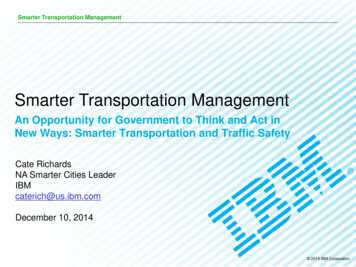
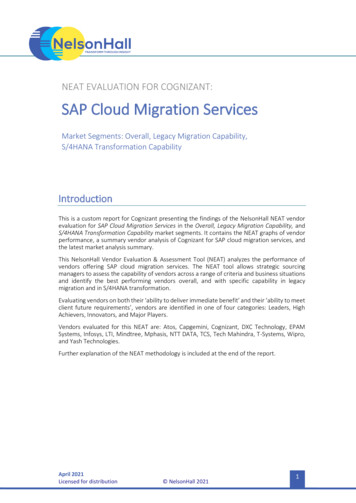



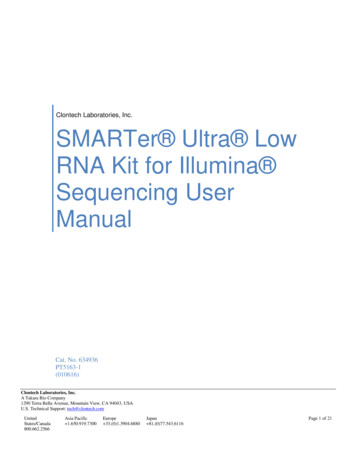

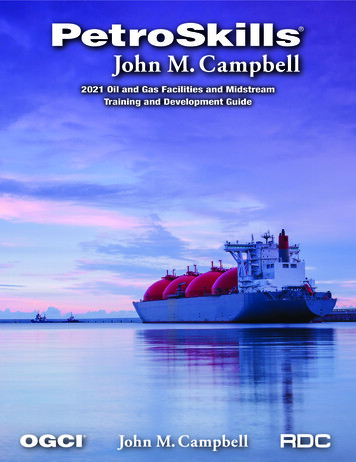
![Smarter Battery Crack [2022-Latest]](/img/13/eliamari.jpg)
